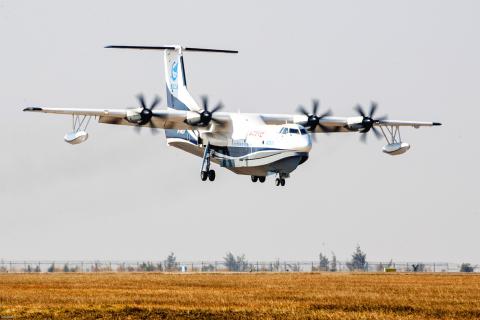China’s homegrown AG600, the world’s largest amphibious aircraft in production, yesterday took to the skies for its maiden flight.
The plane, codenamed “Kunlong,” took off from the southern city of Zhuhai and landed after about an hour-long flight, according to state news agency Xinhua.
With a wingspan of 38.8m and powered by four turboprop engines, the aircraft is capable of carrying 50 people and can stay airborne for 12 hours.

Photo: Reuters
“Its successful maiden flight makes China among the world’s few countries capable of developing a large amphibious aircraft,” chief designer Huang Lingcai told Xinhua.
The aircraft has military applications, but would be used for firefighting and marine rescue, with at least 17 orders placed so far with state-owned manufacturer Aviation Industry Corp of China (中國航空工業), state media reported.
While it is about the size of a Boeing 737, the AG600 is considerably smaller than billionaire Howard Hughes’ flying boat, better known as the Spruce Goose, which had a wingspan of 97m and a length of 67m, but only made one brief flight in 1947.
The AG600’s flight capabilities put all of China’s island-building projects in the South China Sea, where Taiwan also has claims, well within range.
“Its 4,500km operational range and ability to land and take off from water makes it well-suited for deployment over China’s artificial islands,” said James Char, a military analyst at Singapore’s Nanyang Technological University.
The aircraft can fly to the southernmost edge of China’s territorial claims — the James Shoal (Zengmu Shoal, 曾母暗沙) — in just four hours from the southern city of Sanya, state-owned Global Times reported.
The shoal is also claimed by Taiwan and Malaysia, which administers it.
The collection of submerged rocks lies about 80km from Malaysia’s coastline and about 1,800km from the Chinese mainland.
“The plane’s capacity and maneuverability makes it ideal for transporting materiel to those maritime features that are too structurally fragile to support runways,” Char said.
Beijing’s buildup in the South China Sea, through which about US$5 trillion in annual trade passes, is hotly contested by other nations.
The Philippines for many years was one of the region’s strongest opponents of Chinese expansionism, and brought a complaint to a UN-backed tribunal.
The panel last year ruled that China’s territorial claims in the sea were without legal basis, but the Philippines has backed away from the dispute under Philippine President Rodrigo Duterte.
China’s military expenditure last year was an estimated US$215 billion, according to the Stockholm International Peace Research Institute, putting it in first place in Asia, well ahead of India (US$56 billion), Japan (US$46 billion) and South Korea (US$37 billion).

Nvidia Corp yesterday unveiled its new high-speed interconnect technology, NVLink Fusion, with Taiwanese application-specific IC (ASIC) designers Alchip Technologies Ltd (世芯) and MediaTek Inc (聯發科) among the first to adopt the technology to help build semi-custom artificial intelligence (AI) infrastructure for hyperscalers. Nvidia has opened its technology to outside users, as hyperscalers and cloud service providers are building their own cost-effective AI chips, or accelerators, used in AI servers by leveraging ASIC firms’ designing capabilities to reduce their dependence on Nvidia. Previously, NVLink technology was only available for Nvidia’s own AI platform. “NVLink Fusion opens Nvidia’s AI platform and rich ecosystem for

‘WORLD’S LOSS’: Taiwan’s exclusion robs the world of the benefits it could get from one of the foremost practitioners of disease prevention and public health, Minister Chiu said Taiwan should be allowed to join the World Health Assembly (WHA) as an irreplaceable contributor to global health and disease prevention efforts, Minister of Foreign Affairs Lin Chia-lung (林佳龍) said yesterday. He made the comment at a news conference in Taipei, hours before a Taiwanese delegation was to depart for Geneva, Switzerland, seeking to meet with foreign representatives for a bilateral meeting on the sidelines of the WHA, the WHO’s annual decisionmaking meeting, which would be held from Monday next week to May 27. As of yesterday, Taiwan had yet to receive an invitation. Taiwan has much to offer to the international community’s

CAUSE AND EFFECT: China’s policies prompted the US to increase its presence in the Indo-Pacific, and Beijing should consider if this outcome is in its best interests, Lai said China has been escalating its military and political pressure on Taiwan for many years, but should reflect on this strategy and think about what is really in its best interest, President William Lai (賴清德) said. Lai made the remark in a YouTube interview with Mindi World News that was broadcast on Saturday, ahead of the first anniversary of his presidential inauguration tomorrow. The US has clearly stated that China is its biggest challenge and threat, with US President Donald Trump and US Secretary of Defense Pete Hegseth repeatedly saying that the US should increase its forces in the Indo-Pacific region

ALL TOGETHER: Only by including Taiwan can the WHA fully exemplify its commitment to ‘One World for Health,’ the representative offices of eight nations in Taiwan said The representative offices in Taiwan of eight nations yesterday issued a joint statement reiterating their support for Taiwan’s meaningful engagement with the WHO and for Taipei’s participation as an observer at the World Health Assembly (WHA). The joint statement came as Taiwan has not received an invitation to this year’s WHA, which started yesterday and runs until Tuesday next week. This year’s meeting of the decisionmaking body of the WHO in Geneva, Switzerland, would be the ninth consecutive year Taiwan has been excluded. The eight offices, which reaffirmed their support for Taiwan, are the British Office Taipei, the Australian Office Taipei, the